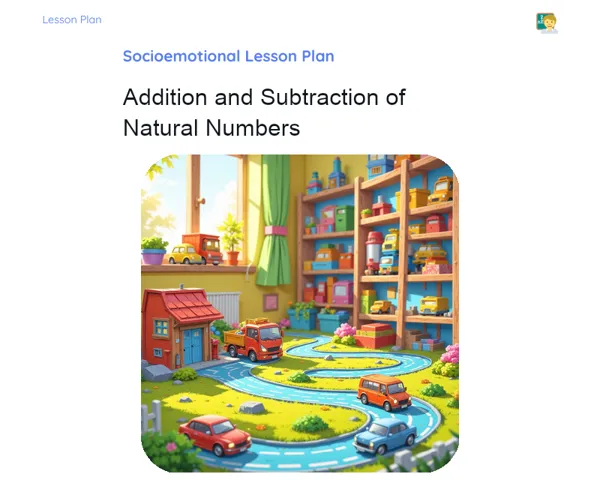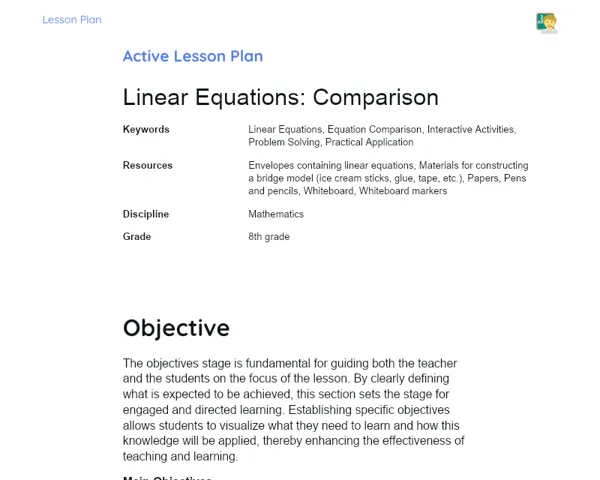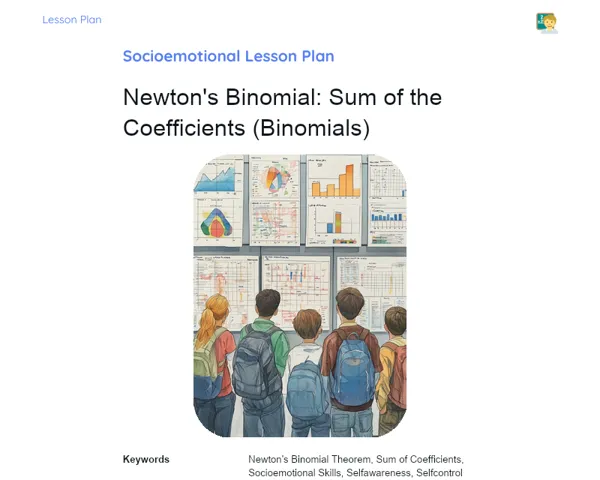Lesson Plan | Lesson Plan Tradisional | Function: Codomain and Range
| Keywords | Function, Codomain, Range, Domain, Mathematics, High School, Practical examples, Problem-solving, Venn diagrams, Quadratic function, Linear function, Absolute value function |
| Resources | Whiteboard, Markers, Projector or smart board, Presentation slides, Worksheets, Calculators, Notebook and pen for note-taking |
Objectives
Duration: (10 - 15 minutes)
The aim of this stage is to familiarize students with the concepts of codomain and range of a function. This foundational understanding will help them recognize the differences between these two terms and learn how to determine the range of a function. Grasping these concepts is vital as it allows students to comprehend the relationship involving domain, codomain, and how this connects to the function's range.
Objectives Utama:
1. Differentiate between the codomain and range of a function.
2. Calculate the range of a given function.
3. Identify when the codomain matches the range.
Introduction
Duration: (10 - 15 minutes)
🎯 Purpose: This stage aims to lay the groundwork for students to understand codomain and range concepts. A clear grasp of these ideas will enable them to see how domain elements relate to the codomain and how this interplay reflects in the function's range.
Did you know?
🔍 Curiosity: Did you know that functions are utilized to create graphs of population growth, predict market trends, and even forecast the weather? Understanding how the elements of the domain (inputs) relate to the codomain (outputs) and the resulting range is essential for making these predictions. For example, recommendation algorithms on platforms like Netflix use these functions to suggest movies and shows relevant to each user’s viewing history.
Contextualization
📘 Context: Begin the lesson by highlighting to students that understanding functions is a cornerstone of Mathematics and intersects with other subjects like Physics, Economics, and even Biology. Functions play a crucial role in describing and predicting real-world behaviours. For instance, a function relating time and distance covered by a vehicle helps calculate the average speed. It’s important that students master the concepts of codomain and range to fully grasp how functions operate.
Concepts
Duration: (45 - 50 minutes)
🎯 Purpose: This stage aims to deepen the understanding of the concepts of codomain and range, providing relevant and detailed examples to aid students in comprehending the differences and similarities between these terms. The questions posed will enable students to apply their newly acquired knowledge, solidifying their understanding through problem-solving.
Relevant Topics
1. 📘 Definition of Codomain: Clarify that the codomain of a function encompasses all potential output values; this is a theoretical construct that doesn't rely on the specific values the function takes.
2. 📘 Definition of Range: Explain that the range of a function represents the actual set of output values produced when every possible input from the domain is applied. Essentially, this denotes the output values that result from executing the function.
3. 📘 Relationship between Domain, Codomain, and Range: Outline the connections between domain, codomain, and range, stressing that the domain consists of all potential inputs, the codomain comprises all possible outputs, and the range consists of actual outputs. Employ Venn diagrams to visually illustrate these relationships.
4. 📘 Examples of Codomain and Range: Provide straightforward examples of functions, such as f(x) = x^2, and outline the domain, codomain, and range. Illustrate how, for f(x) = x^2 with the real number domain, the codomain is the real numbers while the range consists only of non-negative real numbers.
5. 📘 Difference between Codomain and Range: Highlight the distinction between codomain and range by using further examples. For instance, consider the function f(x) = 2x + 1 with an integer domain to demonstrate that although the codomain is all real numbers, the range consists solely of the odd numbers.
To Reinforce Learning
1. 1️⃣ For the function f(x) = x^2 with a real number domain, what is its range? Is the codomain equal to the range?
2. 2️⃣ Analyze the function f(x) = 2x + 3 with the integer domain. What is the range? Discuss whether the codomain is the same as the range.
3. 3️⃣ For the function f(x) = |x| (the absolute value of x) with a real number domain, ascertain the range and the codomain. Are they similar?
Feedback
Duration: (15 - 20 minutes)
🎯 Purpose: This stage focuses on reviewing and consolidating students' understanding of codomain and range, offering them the chance to confirm their responses while delving into detailed explanations. Moreover, the proposed queries and reflections encourage students to participate in a broader discussion about how these concepts apply in various contexts, enhancing their comprehension of the material.
Diskusi Concepts
1. 1️⃣ Question: For the function f(x) = x^2 with a real number domain, what is its range? Is the codomain equal to the range? Explanation: When the domain is the set of real numbers for f(x) = x^2, any real number can be input. Here, the codomain is all real numbers, however, the range includes only the non-negative real numbers (since all outputs of x^2 are greater than or equal to zero). Thus, the codomain does not equal the range. 2. 2️⃣ Question: For the function f(x) = 2x + 3 with an integer domain, what is the range? Discuss if the codomain is equal to the range. Explanation: In the case of the function f(x) = 2x + 3, the outputs generated cover all odd numbers. The codomain here encompasses all real numbers, while the range is limited to just the odd numbers. Therefore, the codomain and range do not match. 3. 3️⃣ Question: Examine the function f(x) = |x| with a real number domain and identify its range and codomain. Are they equivalent? Explanation: For f(x) = |x|, which refers to the absolute value of x, the domain is real numbers. The codomain represents all real numbers since there aren’t any theoretical restrictions. However, the range covers just the set of non-negative real numbers, as the absolute value is never less than zero. Thus, the codomain and range are not equal.
Engaging Students
1. 🤔 Question: How can we practically observe when the codomain equals the range? 2. 💡 Reflection: Why is it vital to differentiate between codomain and range when tackling mathematical problems? 3. 📈 Question: In which everyday scenarios do you suppose knowledge of a function's range is applicable? 4. 🔍 Reflection: How does grasping codomain and range support understanding graphs and functions in other areas like Physics or Economics?
Conclusion
Duration: (10 - 15 minutes)
🎯 Purpose: This final stage aims to recapitulate the key points discussed throughout the lesson, ensuring that students have a firm comprehension of both codomain and range. Additionally, it seeks to emphasize the significance and practical implications of these learnings, underscoring their relevance in daily life and across multiple disciplines.
Summary
['📘 Definition of Codomain: The codomain of a function is the set of all possible output values.', '📘 Definition of Range: The range consists of the specific output values that the function generates when all values from the domain are applied.', '📘 Relationship between Domain, Codomain, and Range: The domain is all possible inputs; the codomain is all potential outputs, while the range signifies what has actually been produced.', '📘 Examples of Codomain and Range: Using specific examples like f(x) = x^2 and f(x) = 2x + 3 aids in discerning the differences between these two concepts.', '📘 Difference between Codomain and Range: The codomain represents a theoretical collection of outputs, whereas the range consists of the realistic results derived from function operations.']
Connection
The lesson effectively links theory and practice through tangible function examples, showcasing how to compute the range and discern the codomain. By employing functions such as f(x) = x^2 and f(x) = 2x + 3, students can appreciate the real-world applications of these concepts in mathematical problem-solving.
Theme Relevance
Grasping the concepts of codomain and range is essential for everyday situations, as they play a significant role in various fields including Physics, Economics, and even in the development of programming recommendation algorithms. For example, streaming services deploy functions to curate content based on viewing histories, which highlights the practical significance of understanding these concepts.



